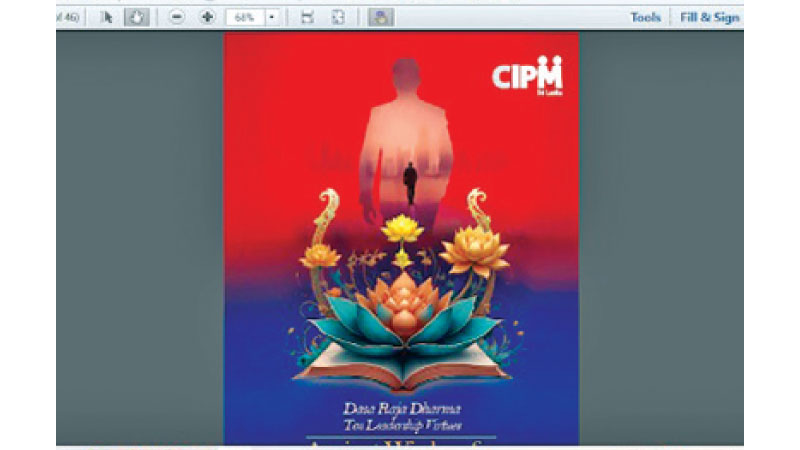 Times are interesting when 39 candidates have come forward to “serve the nation” in seeking the pinnacle post.
Times are interesting when 39 candidates have come forward to “serve the nation” in seeking the pinnacle post.
The public is fed up with nonsensical utterances from so-called leaders. The true virtues of valued leadership are very high in demand. I thought it is an opportune time to discuss a timely research initiative with a deep dive into the availability and applicability of ‘Dasa Raja Dharma’ in the current Sri Lankan context. Today’s column is all about it.
Overview
The Chartered Institute of Personnel Management (CIPM) Sri Lanka embarked on a research project to study the ancient leadership wisdom and to explore the applicability of such rich insights to modern society.
As initiated by Immediate Past President of CIPM, Ken Wijayakumar, Senior Lecturer, Faculty of Management Studies, Rajarata University, Dr. Yashoda Bandara and Senior Lecturer, Sabaragamuwa University, Dr. Rsaika Priyankara, were instrumental in conceptualising the framework and concretising the approach. Many have come forward to contribute to this pioneering initiative showcasing the significance of “indigenous leadership wisdom”.
The two main researchers involved in the project highlighted the salience of their effort as follows: “The role of modern theories, concepts and practices in uplifting the world and human progress is undoubtedly remarkable. However, it is commonly evident that the disparities of development, wealth, and wellbeing continue to prevent the world from becoming an equally fair and comfortable place to all humans, other living beings and nature.
“Beyond contemporary modern knowledge which still has much room for growth in this regard, there exists a vast reservoir of wisdom embedded and hidden in indigenous and religious sources. Traditional knowledge is rich in context-specific and spiritually bound insights, often emphasising the interconnectedness between humans and the natural world while providing more meaningful and sustainable solutions.
“By exploring such knowledge in an unbiased manner, we can uncover sustainable solutions that ensure the wellbeing of all living beings including humans. We believe that embracing ancient wisdom can guide us towards a more harmonious and sustainable future”.
In a nutshell
The concept of Dasa Raja Dharma, the “Ten Kingly Virtues,” is rooted in ancient Sri Lankan wisdom and was practiced by the righteous kings of old. These virtues — generosity, morality, self-sacrifice, integrity, kindness, austerity, non-anger, non-violence, patience, and non-opposition — provided a moral framework for leadership that ensured the welfare and prosperity of the kingdom. By integrating these timeless virtues into modern leadership practices, we aim to cultivate leaders who are not only effective but also ethical and compassionate.
As the researchers illustrate, the Dasa Raja Dharma is referenced in the Chulla Hansa Jataka, which is one of the 550 stories in the Jataka Pali collection found within the Khuddaka Nikaya.
The Khuddaka Nikaya represents the fifth and final division of the Sutta Pitaka, the basket of discourses in the Tripitaka. This division encompasses a diverse array of components, comprising complete suttas, verses, and smaller fragments of Dhamma teachings. Jataka Pali, contains nearly 550 narratives, and recounts episodes from the Buddha’s prior existences before achieving enlightenment. These tales, featured in the Jataka stories, serve to illuminate moral lessons and virtuous qualities while chronicling the Bodhisattva’s journey towards Awakening across numerous lifetimes.
In the Chulla Hansa Jataka, the Bodhisattva (the Buddha-to-be) is born as a wise and compassionate swan who was the leader of a large flock of swans. Once, the king got caught in a hunter’s snare, his commander-in-chief stayed there without leaving him alone and also convinced the hunter to set the Bodhisattva free.
The devotion and love of the commander-in-chief towards his leader and his readiness to sacrifice his life for the leader softened the hunter’s heart, and he released the Bodhisattva, tenderly removing the snare and washing away the blood. In return, the Bodhisattva swan preached the importance of morality to the king. Dasa Raja Dharma, the ten royal virtues are included in this sermon, as follows with an ample explanation on each of the leadership attributes.
“Danam Silam Paricchagam
– Ajjavam maddavam tapam
Akkodham avihimsanca
– Khanthi ca avirodhanam”
Details
The researchers have made an effort to describe each of the ten leadership virtues relating to the current context. The elaborations are as follows”
Dana: As the researchers illustrate, in Buddhism, the act of Dàna is described as the act of generously donating one’s possessions to others. It is characterised by a sense of generosity and a willingness to give away wealth, possessions, or resources for the benefit and welfare of others.
Buddhism recognises three types of Dàna: Amisa dana, Abhaya dana, and Dharma dana. Amisa dana refers to the act of donating food, clothing, medicine, and shelter to Bhikkhus , as well as providing money and material items, including the aforementioned, to laypeople.
Síla: According to the researchers, the term Síla can be seen in ancient literature referring to an approved style of behavior within a particular system that the followers of the system were expected to cultivate. In Buddhism, the concept of Síla is specifically considered as the dedication to maintain a conduct that embraces harmony and self-restraint. It refers to the moral conduct that promotes order and peace in a person’s mind and behaviour, which can be achieved by disciplining one’s mind, body, and words.
Pariccaga: This is known as sacrificing everything for the good of the people, including wealth, power, opportunities, time, and personal comforts. Buddhism specifies five great sacrifices that a Bodhisattva (a Buddha-to-be) would do in the path to enlightenment, including Dhana pariccaga (the sacrifice of wealth), Anga pariccaga (the sacrifice of bodily organs), Putta pariccaga (the sacrifice of son and daughter), Bhariya pariccaga (the sacrifice of wife), and Jivita pariccaga (the sacrifice of life).
Ajjava: As the researchers illustrate, Ajjava explains the quality of being straightforward in making correct decisions and implementing them. The leader should be courageous to discharge the duties and responsibilities entrusted to him without any fear or favour.
He should have that high degree of self-confidence that is powered by honesty and integrity to make unbiased decisions. It is believed that while upholding the public interest a leader should align himself with ethics and moralities.
Maddava: Being kind and gentle is considered as the quality of Maddava. An ideal leader is expected to possess a friendly temperament and a benevolent conduct, where the followers are treated with a fatherly tenderness. Metta, the loving kindness is one of the core concepts in Buddhism. The one who maintains a kind and gentle conduct towards others are blessed with some positive returns. Mettanisansa Sutta (Anguttara Nikaya, 11.16) explains eleven such advantages of Metta, the loving kindness.
Tapa: This is the quality of living a simple life that is not indulged with extreme luxuries. Accordingly, a leader is expected to live a humble and modest life where he makes sensible and meaningful decisions with a substantial level of self-control.
Contentment is highly recognised in Buddhist teachings, where it is viewed as the noblest of all wealth or the condition of highest happiness (Dhammapada, Stanza 204). A contented person is one who is satisfied and pleased with what is available and doesn’t not go looking for luxuries and worldly comforts.
Akkodha: When a leader is free from hatred, ill-will, and enmity, that is said to be the quality of Akkodha. Akkodha is the antonym for the Sanskrit word Krodha or Kodha which means anger. Krodha or the feeling of resentment or hatred, leads the person towards ill will, by arousing the anger and rage in the mind. The leaders who control anger and hold no grudges against anybody would maintain a compassionate conduct towards his followers.
Avihimsa: This is widely known as non-violence. Avoiding harm or violence towards any living beings, be it humans, animals, or oneself, is a core aspect of this principle. It underscores the importance of cultivating compassion and empathy for all sentient beings.
Khanthi: Patience, forbearance, and tolerance are said to be the constituents of the quality of Khanthi. As highlighted in Dhammapada, “The best moral practice is patience and forbearance, Nibbana is supreme, said the Buddhas, A bhikkhu does not harm others, One who mistreats others is not a bhikkhu” (Buddha Vagga, 184).
Avirodha: This refers to a leader’s quality of non-opposition and non-obstruction. Accordingly, he should not oppose the will of the people, should not obstruct any measures that are conducive to the welfare of the people. In other words, he should rule in harmony with his people.
As the researchers observe, this exploration makes it clear that the Dasa Raja Dharma produces a broad and comprehensive conception of leadership that intertwines attributes and behaviours of an ideal leader together with the background necessary to shape such a wholesome leader with prescribed virtues.
Research approach
There are hardly any studies that attempt to elaborate unique leadership principles based on specific aspects of indigenous or religious knowledge in the Sri Lankan context, observe the researchers.
The absence of comprehensive studies on the integration of Buddhist principles into leadership and management practices creates a void in understanding how these ancient wisdom traditions could potentially address contemporary organisational challenges.
As a result, such understanding remains mostly inattentive in mainstream education. This lacuna hinders the potential opportunity to develop a more holistic and culturally inclusive approach to leadership and management that could benefit individuals, organisations, and society at large.
In line with its exploratory nature, the researchers have taken an interpretive, naturalistic and qualitative approach. The study mainly focuses on developing a descriptive account on Dasa Raja Dharma; a theory of royal virtues explained in Sutta Pitaka (Kutdantha/ Chakkavatti Sihanada Sutta), by employing a directed content analysis, a methodological choice fairly adopted for exploring religious and spiritual concepts.
The volume of qualitative material found in Buddhist literature relating to Dasa Raja Dharma was used to draw the categories while identifying core consistencies and meanings.
Mostly the knowledge of Theravada Buddhism is constituted in Pali Canons called Tripitaka. The Tripitaka is considered the oldest and most authoritative collection of Buddhist teachings. It is divided into three categories, Vinaya Pitaka (teachings relating to monastic discipline), Sutta Pitaka (teachings relating to discourses), and Abhidamma Pitaka (teachings relating to deep philosophy).
Among them, Sutta Pitaka covers a wide range of discussions and insights relating to spiritual, ethical, social, economic and political realities acknowledged in Buddhism. Finding relevant text from among the extant Buddhist literature was done by obtaining continuous guidance from experts including the bhikkhus.
The texts they referred to were found and carefully examined to gather data. Initial coding started with the theory, finding supporting evidence from identified relevant Buddhist literature including Sutta Pitaka and scholarly work in the field. Categories were formed as supported by the data, and a detailed description on each aspect of Dasa Raja Dharma was developed by identifying the core meanings.
Way forward
Research on indigenous management and leadership practices are indeed commendable as they fulfill a lacuna with practical and applicable insights. At a time when we see more the absence than the presence of the leadership virtues, we look forward to receiving the findings illustrated in an impactful sense, with immense significance to leaders of institutional and national levels alike.







